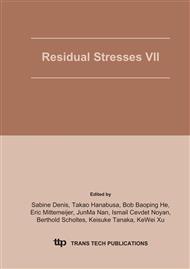p.340
p.346
p.352
p.358
p.364
p.370
p.376
p.384
p.390
Residual Stress in a Quenched Gear Shaft Treated by Water Cavitation Peening
Abstract:
Water cavitation technique can be applied to modify the surface strength of materials as an attractive new peening route. By inducing cavitation of ultrahigh speed water due to water-jet, the numerous impacts induced by the cavitation bubbles impact can produce compressive residual stress on material surface in the similar way as that by shot peening. In the present paper, an automobile part of steel gear shaft with complex shape is processed by water peening process. Compressive residual stress induced by water peening was measured to investigate the surface strengthening effect as a quantitative factor. The residual stresses on the tooth surface of the gear are measured by X-ray diffraction method. The effect of process conditions such as water outlet pressure, standoff distance of the nozzle, and peening time are discussed. To investigate the effect of heat treatment, carburizing-quenching is implemented to the gear shaft. By comparing the residual stresses of the tooth before and after water peening, the effectiveness of water peening process on surface strengthening is verified for a quenched gear shaft.
Info:
Periodical:
Pages:
364-369
Citation:
Online since:
July 2005
Authors:
Price:
Сopyright:
© 2005 Trans Tech Publications Ltd. All Rights Reserved
Share:
Citation:


